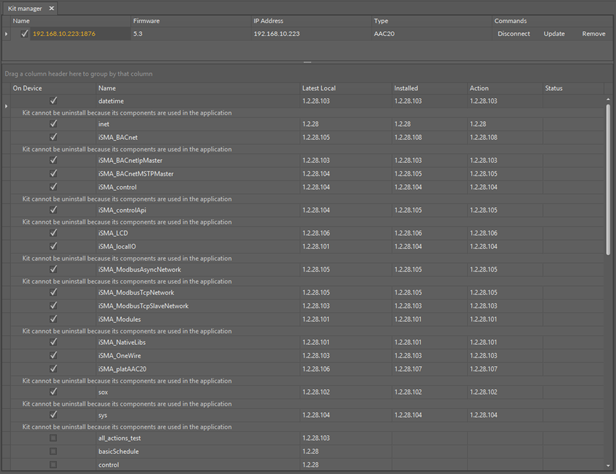Kit Manager
The Kit Manager Tool is used to manage kits on Sedona devices. The kits.scode file is a file which contains a set of kits in a Sedona Framework code image file with an .scode extension. The scode image is executed by the SVM (Sedona Virtual Machine) in the device. Using the Kit Manager, it is possible to add and remove kits, as well as change versions of kits deployed in the scode running on the device. Also, there is an option to force the kits.scode to be rebuilt. The kits.scode must be rebuilt whenever a change affects the schema. This ensures such changes are included in the recompiled binary .scode image. When any kit selection changes are made in the Kit Manager, it automatically selects and check this option. The only time the user would select this option is when the user wants to force the scode to be rebuilt (even if no change was made to kit selections). This option is most useful in a development environment where the actual code in a kit might change while the kit version and checksum do not. In this case, no change is required in the Kit Manager but the scode must be regenerated in order to deploy the new code on a device.
Using Kit Manager
The Kit Manager tool is used to manage kits on Sedona devices. The Kit Manager shows a table with a list of kits. In the upper part of the table the kits, which are currently installed in the device, are grouped, and in the lower part of the table there are filtered kits, fitting to a selected device, which are available to be loaded into the device. After deselecting the device, the filter will be turned off, and a whole list of locally available kits will be shown in the iSMA Tool, see the figure below.

The columns in the above table are defined as follows:
- On Device: shows if a particular kit is already installed on the selected device;
- Name: the name of the kit;
- Latest Local: the number of the latest kit version installed locally in the iSMA Tool;
- Installed: the number of the kit version currently installed on the device;
- Action: the list of kits versions, which are available locally in the iSMA Tool and are ready to be installed on the device. A version number to be installed on the device is chosen from a drop-down menu (upgrade or downgrade process).
- Status: the column informs about an action that will be taken on the selected kit.
The user's role is limited to editing two columns: On Device and Action.
Below there are descriptions how to remove, replace, and add a kit to a device.
Removing (Uninstalling) the Kit from the Device
If a user deselects the checkbox, the selected kit is chosen to be removed. The Uninstall command appears in the Status column, and the kit is removed once the user confirms the Update command in the upper Device panel of the Kit Manager.

It may happen that the removal of the kit is not possible due to connections between kits, or because the component, which is used in the application, is a part of the removed kit. Such information is displayed under the kit’s name.

In order for the kit to be removed, the components used in the application shall be removed, or the kit needs to be left installed.
Replacing the Kit Existing in Device to a Newer, or Older one
The kit installed on the device may be replaced by installing its newer or older version. Both upgrade and downgrade operations are done by choosing a proper number of the kit version in the Action column.

Depending if the current kit is replaced with a newer or older one, the iSMA Tool will display the planned action in the Status column, Upgrade, or Downgrade.

Adding (Installing) the Kit to the Device
In order to add the kit to the device, select its checkbox , and, if needed, define the version of added kit (by default, the newest version is selected). The Install command appears in the Status column, and the kit is added once the user confirms the Update command in the upper Device panel of the Kit Manager.

Updating Kits in the Device
After defining the kits to be added, removed, or changed the Update command needs to be confirmed in the upper Device panel of the Kit Manager. The Update command is displayed in the Commands column.

While updating the kits in the device, the iSMA Tool interface is blocked for the time.
WARNING! Finalizing the kits update requires restarting the device. After restarting the device iSMA Tool reconnects with the device.
Note: The update process is monitored in detail in the Console window, which helps in analyzing the situation in case the update could not be completed.
